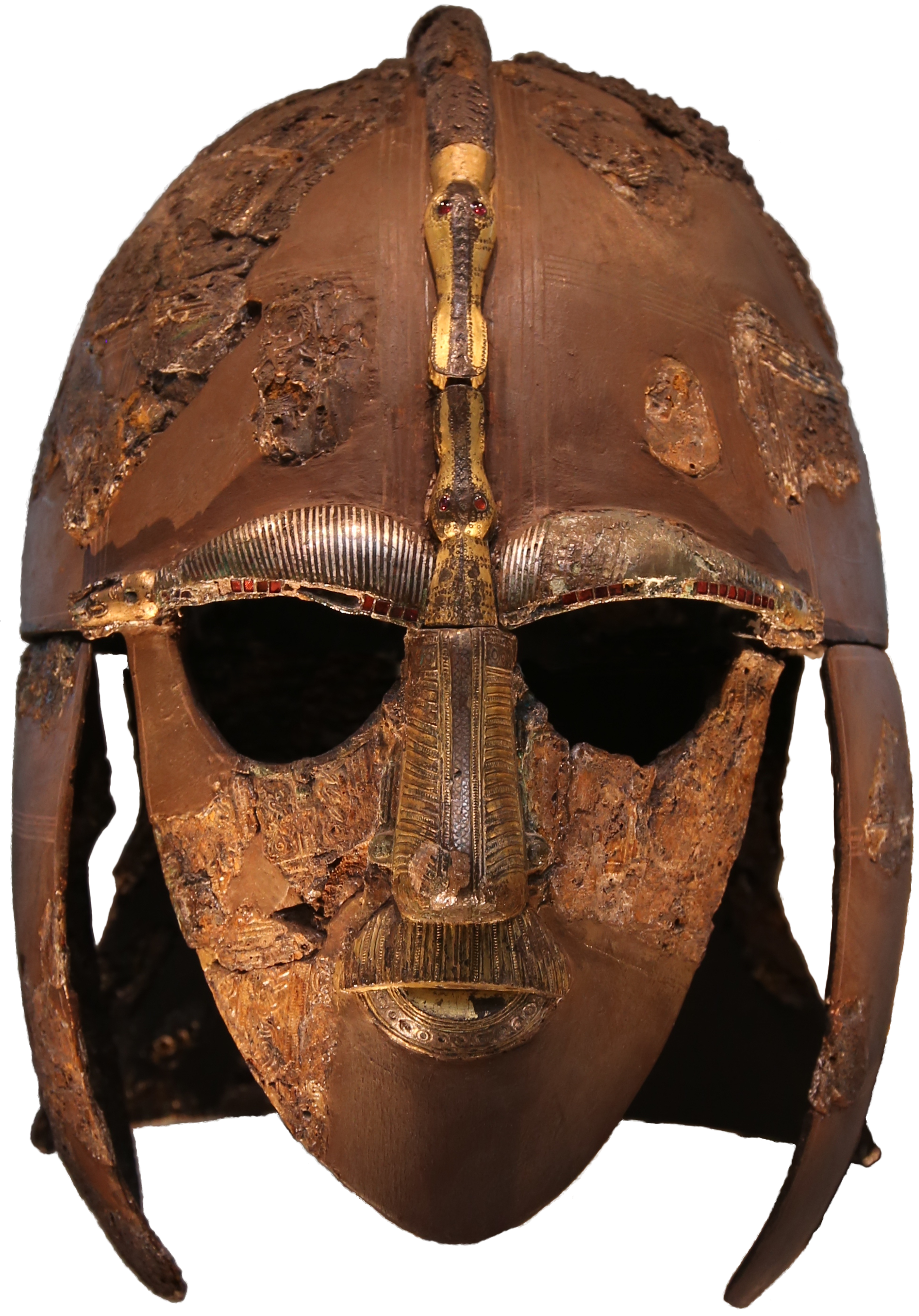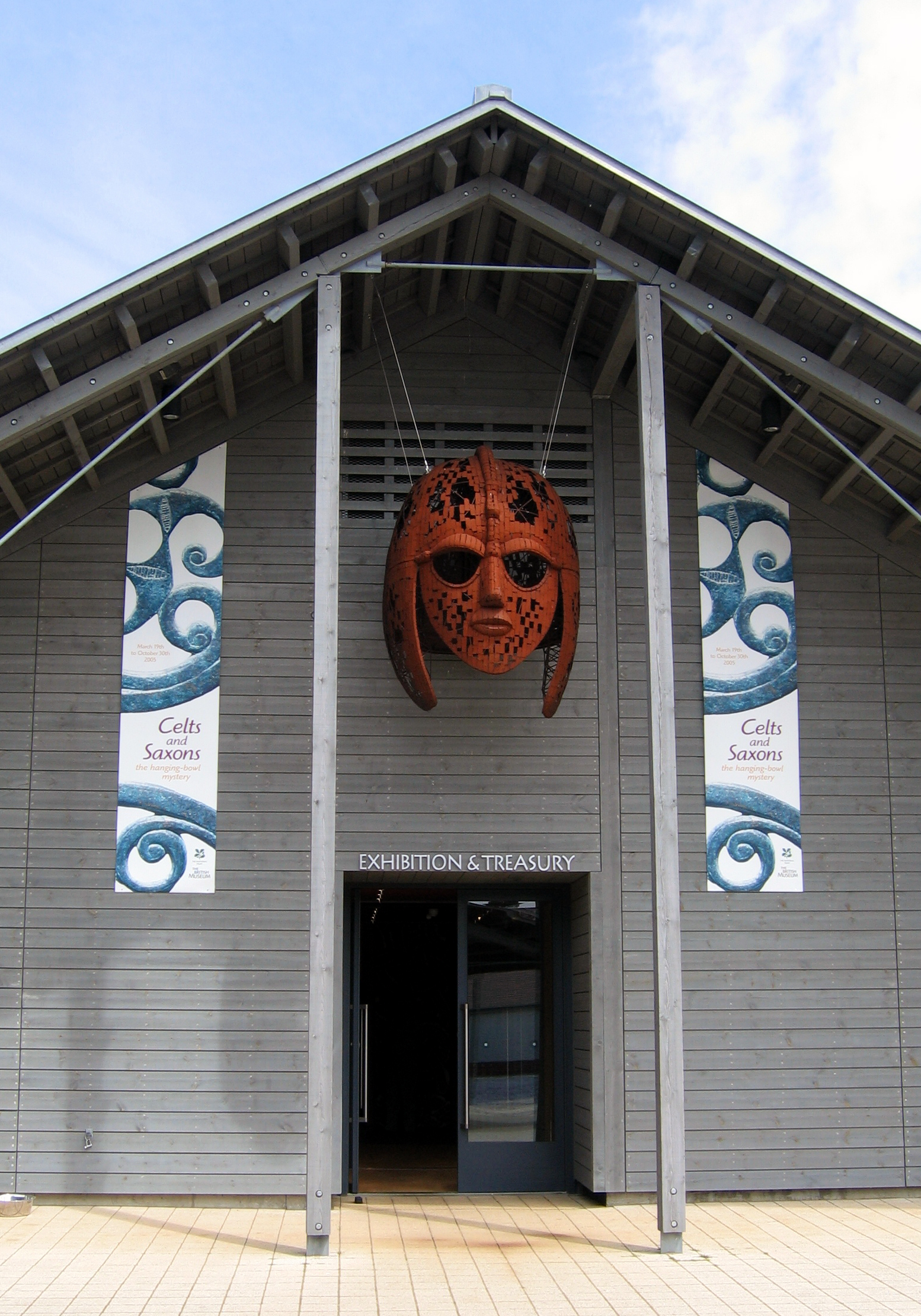Sutton Hoo Helmet (sculpture) on:
[Wikipedia]
[Google]
[Amazon]
''Sutton Hoo Helmet'' is a 2002 sculpture by the English artist
 In 1939, archaeologists excavating barrows overlooking the
In 1939, archaeologists excavating barrows overlooking the  The Sutton Hoo finds were donated to the
The Sutton Hoo finds were donated to the
 Kirby's sculpture is based on the famous helmet found in the Sutton Hoo ship-burial, but is rendered on a much larger scale. It is made from of mild steel plates that have been coloured red, and is high, wide, and deep. The external structure rests on an internal steel frame. By contrast, the actual helmet is high, wide, deep, and originally weighed an estimated .
Like the fragmented Anglo-Saxon helmet, Kirby's work is made of many pieces of metal, evoking an object reconstructed by an archaeologist. The sculpture intentionally emulates the fragmentary appearance of the helmet's second reconstruction, reassembled from 1970 to 1971 by Nigel Williams, rather than the glistening replica made by the
Kirby's sculpture is based on the famous helmet found in the Sutton Hoo ship-burial, but is rendered on a much larger scale. It is made from of mild steel plates that have been coloured red, and is high, wide, and deep. The external structure rests on an internal steel frame. By contrast, the actual helmet is high, wide, deep, and originally weighed an estimated .
Like the fragmented Anglo-Saxon helmet, Kirby's work is made of many pieces of metal, evoking an object reconstructed by an archaeologist. The sculpture intentionally emulates the fragmentary appearance of the helmet's second reconstruction, reassembled from 1970 to 1971 by Nigel Williams, rather than the glistening replica made by the
Rick Kirby
Rick Kirby (born 1952) is an English sculptor born in Gillingham, Kent. He started his career as an art teacher, before quitting after sixteen years to focus on his work. Much of his work is figural, reflecting an interest in the human face a ...
. A representation of the Anglo-Saxon helmet by the same name found in the Sutton Hoo ship-burial, it was commissioned by the National Trust
The National Trust, formally the National Trust for Places of Historic Interest or Natural Beauty, is a charity and membership organisation for heritage conservation in England, Wales and Northern Ireland. In Scotland, there is a separate and ...
to suspend outside an exhibition hall at the Sutton Hoo visitor centre. At the opening of the centre, the sculpture was unveiled by the Literature Nobel laureate Seamus Heaney
Seamus Justin Heaney (; 13 April 1939 – 30 August 2013) was an Irish poet, playwright and translator. He received the 1995 Nobel Prize in Literature.
on 13 March 2002. It remained in place, dominating the entrance of the exhibition hall, until 2019, when it was moved to the entrance to the Sutton Hoo site.
The sculpture is high, wide, deep, and weighs . It is made of mild steel plates that are coloured red. Designed to have a "fierce presence", it is inspired by the fragmentary appearance of the reconstructed helmet rather than the glistening replica made by the Royal Armouries
The Royal Armouries is the United Kingdom's national collection of arms and armour. Originally an important part of England's military organization, it became the United Kingdom's oldest museum, originally housed in the Tower of London from ...
. Steel is Kirby's favoured medium, allowing the sense of scale and dramatic impact found in ''Sutton Hoo Helmet''. The sculpture is illustrative of Kirby's largely figural body of work, and its mask-like quality has been repeated in subsequent pieces.
Background
 In 1939, archaeologists excavating barrows overlooking the
In 1939, archaeologists excavating barrows overlooking the River Deben
The River Deben is a river in Suffolk rising to the west of Debenham, though a second, higher source runs south from the parish of Bedingfield. The river passes through Woodbridge, turning into a tidal estuary before entering the North Sea at F ...
near Woodbridge, Suffolk, discovered an Anglo-Saxon grave of unparalleled wealth. The Sutton Hoo ship-burial was quickly labelled "Britain's Tutankhamun
Tutankhamun (, egy, twt-ꜥnḫ-jmn), Egyptological pronunciation Tutankhamen () (), sometimes referred to as King Tut, was an Egyptian pharaoh who was the last of his royal family to rule during the end of the Eighteenth Dynasty (ruled ...
"; the finds reshaped views of what was then termed the Dark Ages, which—with new understandings of its wealth and sophistication—became known as the Middle Ages
In the history of Europe, the Middle Ages or medieval period lasted approximately from the late 5th to the late 15th centuries, similar to the post-classical period of global history. It began with the fall of the Western Roman Empire ...
. The most iconic artefact, the Sutton Hoo helmet
The Sutton Hoo helmet is a decorated Anglo-Saxon helmet found during a 1939 excavation of the Sutton Hoo Ship burial, ship-burial. It was buried around 625 and is widely associated with King Rædwald of East Anglia; its elaborate decoration ma ...
, was pieced together from more than 500 fragments. In the decades since, the Sutton Hoo helmet has come to symbolise the Middle Ages, archaeology, and England.
 The Sutton Hoo finds were donated to the
The Sutton Hoo finds were donated to the British Museum
The British Museum is a public museum dedicated to human history, art and culture located in the Bloomsbury area of London. Its permanent collection of eight million works is among the largest and most comprehensive in existence. It docum ...
within weeks. The estate was privately owned until 1998, when its 245 acres, and Tranmer House (originally Sutton Hoo House and renamed by the Trust in honour of the donor), were bequeathed to the National Trust
The National Trust, formally the National Trust for Places of Historic Interest or Natural Beauty, is a charity and membership organisation for heritage conservation in England, Wales and Northern Ireland. In Scotland, there is a separate and ...
. In 2000 the Trust commissioned van Heyningen and Haward Architects
van Heyningen and Haward is an architectural practice, founded in 1983 by Birkin Haward and Joanna van Heyningen, and now owned and managed by James McCosh and Meryl Townley. The London architects work primarily in education, and have also work ...
to design a visitor centre. Their work included the overall planning of the estate, the design of an exhibition hall and visitor facilities, car park, and the restoration of the Edwardian house. The £5million visitor centre (equivalent to £million in ) was opened on 13 March 2002 by Nobel laureate Seamus Heaney
Seamus Justin Heaney (; 13 April 1939 – 30 August 2013) was an Irish poet, playwright and translator. He received the 1995 Nobel Prize in Literature.
, whose translation
Translation is the communication of the meaning of a source-language text by means of an equivalent target-language text. The English language draws a terminological distinction (which does not exist in every language) between ''transla ...
of '' Beowulf'', an Anglo-Saxon epic poem
An epic poem, or simply an epic, is a lengthy narrative poem typically about the extraordinary deeds of extraordinary characters who, in dealings with gods or other superhuman forces, gave shape to the mortal universe for their descendants.
...
that describes extravagant burial customs similar to those observed at Sutton Hoo, had been published in 1999.
The National Trust commissioned the English sculptor Rick Kirby
Rick Kirby (born 1952) is an English sculptor born in Gillingham, Kent. He started his career as an art teacher, before quitting after sixteen years to focus on his work. Much of his work is figural, reflecting an interest in the human face a ...
to create a work for the visitor centre. He was tasked with making something with a "fierce presence". Kirby's works then included several public commissions, among them a sculpture outside St Thomas' Hospital, unveiled by Princess Margaret in 2000, and another in the Calne
Calne () is a town and civil parish in Wiltshire, southwestern England,OS Explorer Map 156, Chippenham and Bradford-on-Avon Scale: 1:25 000.Publisher: Ordnance Survey A2 edition (2007). at the northwestern extremity of the North Wessex Downs ...
town centre, announced by Queen Elizabeth in 2001. The National Trust ''Sutton Hoo Helmet'' was winched into place above the entrance of the exhibition hall on 26 February 2002, ahead of its official unveiling in March. The sculpture remained above the doors, dominating the entrance, until 2019; on 30 May it was installed in a new location at the entrance.
In the course of making the sculpture, Kirby completed a mock-up, or maquette
A ''maquette'' (French word for scale model, sometimes referred to by the Italian names ''plastico'' or ''modello'') is a scale model or rough draft of an unfinished sculpture. An equivalent term is ''bozzetto'', from the Italian word for "sketc ...
. The maquette, high with pedestal, was offered for sale by a private art gallery in 2005, with an asking price of £9,600.
Description
 Kirby's sculpture is based on the famous helmet found in the Sutton Hoo ship-burial, but is rendered on a much larger scale. It is made from of mild steel plates that have been coloured red, and is high, wide, and deep. The external structure rests on an internal steel frame. By contrast, the actual helmet is high, wide, deep, and originally weighed an estimated .
Like the fragmented Anglo-Saxon helmet, Kirby's work is made of many pieces of metal, evoking an object reconstructed by an archaeologist. The sculpture intentionally emulates the fragmentary appearance of the helmet's second reconstruction, reassembled from 1970 to 1971 by Nigel Williams, rather than the glistening replica made by the
Kirby's sculpture is based on the famous helmet found in the Sutton Hoo ship-burial, but is rendered on a much larger scale. It is made from of mild steel plates that have been coloured red, and is high, wide, and deep. The external structure rests on an internal steel frame. By contrast, the actual helmet is high, wide, deep, and originally weighed an estimated .
Like the fragmented Anglo-Saxon helmet, Kirby's work is made of many pieces of metal, evoking an object reconstructed by an archaeologist. The sculpture intentionally emulates the fragmentary appearance of the helmet's second reconstruction, reassembled from 1970 to 1971 by Nigel Williams, rather than the glistening replica made by the Royal Armouries
The Royal Armouries is the United Kingdom's national collection of arms and armour. Originally an important part of England's military organization, it became the United Kingdom's oldest museum, originally housed in the Tower of London from ...
. ''Sutton Hoo Helmet'' was described by the National Trust as "fantastic—such a striking image and it has a real wow factor", and by the ''East Anglian Daily Times
The ''East Anglian Daily Times'' is a British local newspaper for Suffolk and Essex, based in Ipswich.
History
The newspaper began publication on 13 October 1874, incorporating the ''Ipswich Express'', which had been published since 13 August ...
'' as an "iconic" sculpture greeting visitors to the site.
Both the material and the subject are typical of Kirby's work. Steel is Kirby's material of choice, for what he describes as "the ability to go huge" and its "whoom-factor!" Much of Kirby's other work focuses on the human face and form, and his later pieces ''Masks'' and ''Vertical Face'' repeat the same staring, unemotive quality.
References
Bibliography
* * * * * * * * {{featured article 2002 sculptures Steel sculptures in England Outdoor sculptures in England Arts in Suffolk Sutton Hoo